Have you ever put hours of work into something… and your results sucked?
That’s how I used to feel with YouTube.
I’d spend hours coming up with ideas, shooting content, and trying hard:
- Making funny intros to try and grab your attention
- Sharing insanely vulnerable + personal details
- Asking famous guests to join me on my videos
But the results were super meh.
I was putting in the time… but I wasn’t getting the results. My mission to grow my YouTube channel to 100,000 subscribers was failing.
So I asked Tim Schmoyer to help.
Tim is a YouTube genius who’s helped some of YouTube’s top earners — people with 5+ million subscribers — grow their channel.
In part 1 of our talk, we discussed the simple tips to optimize your YouTube channel for massive growth.
In part 2, you’ll learn specific strategies to get people watching your content:
- How to find famous people to help grow your channel — and convince them to collaborate
- Strategies to help you decide which videos to make (and predict what will be popular)
- How often to post your videos for maximum effect
- 2 key strategies to get more juice from your old videos
Check out the tips below…
1. How to do successful YouTube collaborations
Collaborations are HUGE on YouTube.
A collaboration is when two or more YouTube creators work together to produce content and co-promote their channels.
Here’s an example on my own channel with Barron Cruz.
For example, when Casey Neistat and Roman Atwood collaborated they generated over 10 million views across their two channels. 🔥🔥🔥
It was a GREAT way for Casey and Roman to get new subscribers, too.
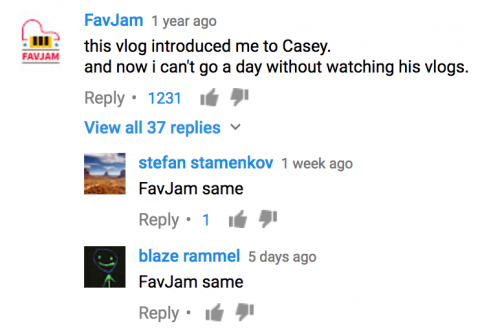
To grow your channel, you need to do as many collaborations as possible.
Here’s a pro tip: Don’t focus on just bigger creators.
Much like marketing, bigger doesn’t always mean better. Aim to work with creators of all sizes:
- Small creators sometimes have the most loyal, action-oriented audiences
- When you start small, you build leverage and connections to work your way up
- Some small creators can make it big — and you’ll be one of the first to know them
If you come across a small channel producing videos you love, don’t be put off by the views or subscriber numbers. Reach out to them.
And remember, it can take time to get a collab going — even with smaller channels.
The problem most people run into with collaborations is thinking too near-term.
Most people want instant rewards and only think about how someone can help them.
Real, valuable relationships never work near-term. Thing LONGER.
For example, I’d known Ryan Holiday for years before I asked him to collaborate on a few videos for my YouTube channel.
It’s the same story with Tim Ferriss — we’d known each other for about 15 years before he joined me on a podcast episode.
You can even see him in the background of one of my SUPER early videos!
My advice here is pretty simple: Offer value first.
Approach collabs like you would approach networking with super important VIPs.
Here are two ways you could build relationships with potential collaborators.
| BONUS: How to get 100,000 YouTube subscribers |
1. Create something for them
Constantly creating content is hard work.
One of the best ways you can build a relationship with someone is to help make their lives easier by reducing their workload.
For example, when I interviewed Tim Ferriss for my podcast, he was about to launch Tools of Titans.
By featuring Tim as a guest, I was able to help him reach a new audience.
Think about how you could help a fellow YouTuber by promoting their work.
You don’t even need to know the person for this strategy to work!
For example, when YouTuber Sara Dietschy created a video called How to Casey Neistat a vlog she didn’t know Casey. But she helped viewers understand Casey’s techniques and strategies.
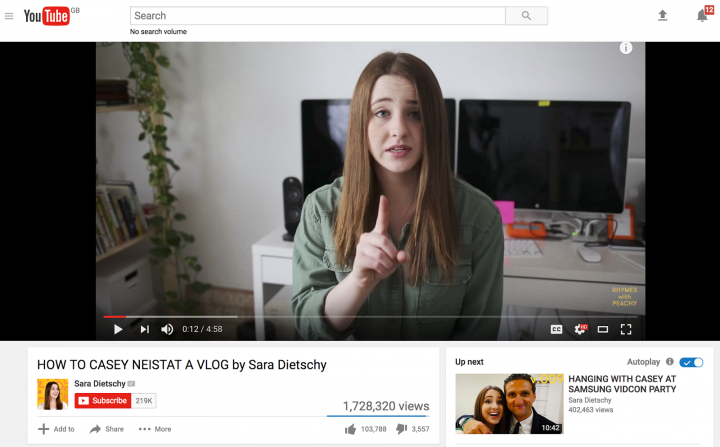
The video has generated over 1.7 million views — and grabbed Casey’s attention. Casey talked about Sara in one of his vlogs and added a link back to subscribe to her channel.

Casey promoted Sara because Sara showed off Casey to her followers — without asking anything from Casey in return.
In order to start a relationship, GIVE first and ASK second.
Like the author of one of my favorite books mentions, “the score takes care of itself.” Add real value, and you’ll start to receive value in return.
Here are a few ways you could create something valuable for someone:
- Create a review: Maybe your favorite entrepreneur just released a book or an epic new video. You could produce a video of your own to share lessons you’ve learned from their content.
- Say “thanks:” Inspired by someone? Let them know. One thing that will never get old is receiving an email about how my content has helped someone else. It means the world to me. Create a video and explain why you’re thankful for another YouTuber.
- Analyze success: People love to understand why others are successful and what you can learn from them. For example, our blog post on Intercom’s explosive growth is one of my most popular ever. Do a video breakdown of their content, strategies, or business approach — and share it with your followers.
2. Share their content
This strategy is simple… and it works.
I’ll break it down in three steps:
- Message a popular YouTube creator and ask if it’s okay to share their content (they’ll say yes)
- Share their content on social, email, carrier pigeon… and however else
- Let them know when you’ve shared it
This is similar to how Charlie got my attention and won my recent contest.
Sharing their content is the start of your relationship.
By following up, once you’ve shared it, you can add even more value.
For example, if Tim Schmoyer shares someone’s content with his audience (over 300,000 subscribers on YouTube and 40,000 YouTube creators via email), he can 10x the reach of a video for most creators.
This is extremely valuable for two reasons:
- Tim can promote the content to his followers — and get a nice boost in traffic for his new friend
- Tim can collect feedback on the video, and share the results with the video creator so the creator can make his future content even better
By sharing this feedback, he’s generated a ton of value and potential learning opportunities.
From there, he can continue to build that relationship until he feels ready to discuss a potential collaboration.
2. Predict which videos will be popular
I’m not a fan of wasting time.
I love to have processes in place and plan ways to reverse-engineer success.
Whenever I create, I like to know it has a good chance of success. I don’t want to throw a bunch of random 💩 against a wall and hope some of it sticks.
To successfully grow your YouTube channel, you need to produce two types of content:
- Searchable and discovery content
- Community content
Searchable and discovery content
“When you’re growing a YouTube channel, 70% of your traffic should come from suggested videos.”
Suggested video feeds are on the right side of a YouTube video.
Before speaking to Tim, the idea of creating videos specifically optimized to appear in suggested video feeds never crossed my mind.
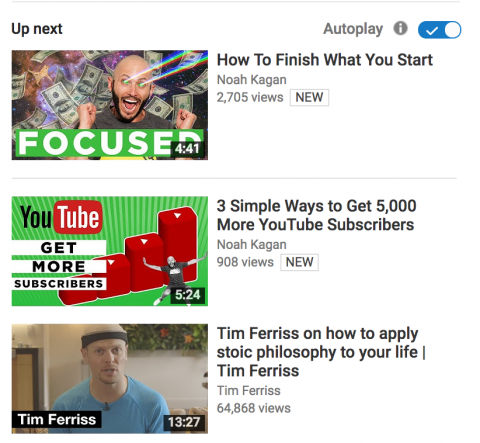
Tim calls these videos “search and discovery” content. You have to do your research to successfully execute this strategy.
Here’s how it works:
- First, search your niche on YouTube for videos with high view counts on the video but low subscriber counts. You want to look for that content that’s performing based on its own merit, not just because it’s been published on a large channel
- Make note of titles, thumbnail design, and content for highly-performing videos (aka what does the video cover?)
- Apply these learnings to your video in order to create something that’ll have a good chance of being featured as a suggested next to one of the popular videos
Here’s what that process looks like IRL…
Recently, Tim was creating a video for a family channel on YouTube. The subject of his vlog was potty training his young son. (It must be super weird having kids sometimes… 🚽)
He wanted to figure out what he should focus on:
- Potty training
- Bathroom accidents
- Wetting pants
To figure out the answer, he searched those phrases in YouTube to see what content had high views, but low subscribers.
Tim saw that potty training was performing way better than accidents or wetting pants.
Through his research, Tim was also able to reverse-engineer an epic title and thumbnail combination to beat the competition and dominate the keyword. Hell yeah, Tim! 👍
Community content
The second type of content you should be creating is community content.
Community content is the stuff that you’re making FOR your audience.
It’s not something they’re going out and searching. Instead, it’s content that might not be as searchable… but your readers, fans, and followers really like.
For my channel, this means stuff like:
- How To Finish What You Start
- 3 Strategies to Start a Side Hustle TODAY
- The Billionaire Mindset: How to Reach Insane Goals
Don’t eliminate an idea just because it doesn’t follow have discoverability.
When you’re growing a channel, I recommend 70% discoverable and 30% community. Reward your most loyal followers with epic content instead of trying to optimize everything.
3. Why you NEED to post frequently
It’s becoming harder and harder to grow a channel on YouTube.
Before, I was posting on YouTube 2x per week.
After talking with Tim, I upped my frequency to 3x per week.

YouTube’s algorithm favors content that brings people back to YouTube regularly.
As YouTube becomes more popular, viewers are turning to YouTube for their daily content consumption.
Just look how the interest in “daily vlogs” has grown over recent years:
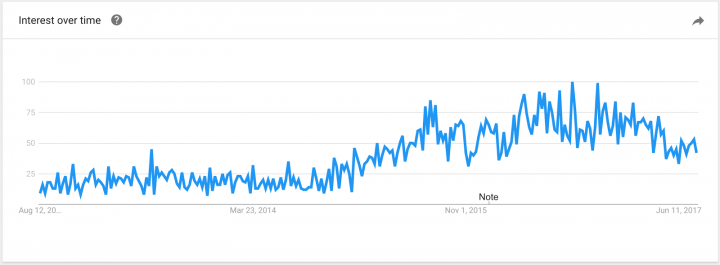
People crave routine and YouTube is taking the place of TV.
The creators who are cranking out content daily have way more potential to be discovered in searches and related video sections… which drives the growth of their channel.
If you want to grow a channel, daily (or weekday content) is now a must, not an option.
To start experimenting, try posting videos Tuesday and Friday.
Once you’ve nailed down the quality and promotion for two days a week, move to Monday, Wednesday, Friday (like me).
Then, keep building, measuring results, and launching experiments. 🎥
| EXPERT TIPS: How to grow your YouTube subscribers |
4. How to make your old videos go viral
I have a bunch of old videos on YouTube.
90% of them don’t perform very well. I thought it was because the content sucked or people hated me. 😢
Nope! After speaking with Tim, there are 3 main issues for a low-performing video:
- Poor titles
- Lame thumbnails
- Boring, slow introductions
#guilty. Look at how slow my earlier videos start.
Even if the main takeaways are valuable, people won’t sit through boring lead-up to get there. To get more out of your pre-existing content, you have two options:
- Refresh the details
- Complete relaunch
1. Refresh the details
First impressions matter.
And a first impression comes before the viewer has even clicked on your video. If the thumbnail and title are dull AF, you won’t be getting any views.
Just check out this old ass thumbnail from one of my OG YouTube videos:
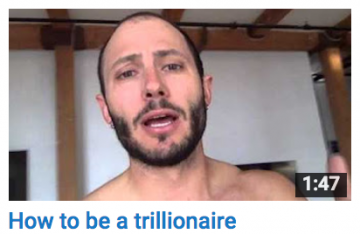
SMH. What the hell was I thinking.
Now compare that to one of my recent uploads:
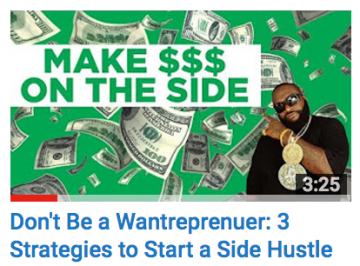
BOOM! Way, way, way better. 💪
When refreshing the details, you simply go through your old videos and update the main YouTube SEO triggers.
Here’s a simple refresh checklist:
- Update the title — you can even split test with a small Facebook Ads budget
- Add a better description (make sure the first line hooks!)
- Create a new thumbnail
- Re-promote to increase attention — aka share via email, social media, etc.
2. Complete relaunch
If your video topic is good, but your video execution totally sucks, there’s a super hardcore — and effective — way to “upgrade” your videos.
It revolves around reverse engineering viral success.
Here’s how it works:
- Take one of your underperforming videos
- Edit 5-10 variations — and focus especially on making the first 15 seconds kick-ass
- Upload all the edits as unlisted videos on your channel
- Promote each with Facebook Ads using different combinations of titles and thumbnails (you only need to spend $5-10 per video)
- Analyze your results and combine the best performing video (the one people watched longest) with the title and thumbnail that generated the most clicks
That may sounds like a lot, but Tim knows people who’ve used this strategy to build an entire company off the back of viral video success using this method.
To massively grow your YouTube channel — and get more attention to your business, connect with more VIPs, and more — check out the full podcast below.

3 responses to “How YouTube’s Top Earners Promote Their Content and Grow Their Audience”
Thanks for the advice. I am using Facebook Ads to promote my puppet blog–don’t laugh. It’s my retirement activity. I’m retiring from my water filter business. I found you searching Tim Schmoyer. I did parody on Tim & Derral Eves
This is a great article. It sounds like a lot of work (and it is), but running a Youtube channel is a lot of work and rewarding too. I think it is often hard to work out whether people are searching for what you offer and getting those titles and thumbnails are very tricky. But practice and being open to new ideas and testing things is usually the best way to work it out. Thanks for sharing your thoughts. Really usual and inspirational.
Awesome article for the aspiring vbloggers 🙂